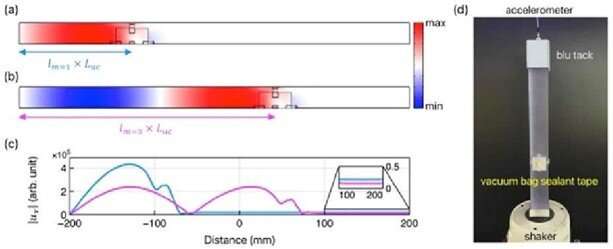This article has been reviewed according to Science X's editorial process and policies. Editors have highlighted the following attributes while ensuring the content's credibility:
fact-checked
trusted source
proofread
Bound states in the continuum is possible in the acoustoelastic coupling

Let's imagine a hypothetical scenario where two individuals are gripping a rope, each holding one end. Person A proceeds to shake the rope in an up-and-down motion, thus generating a propagating wave that travels towards person B. Now, if person C, positioned between person A and B, engages in a comparable frequency of waving motion as that of the rope's wave, could the wave be redirected back to person A rather than reaching person B?
Initially, this situation appears implausible, as person C does not physically interact with the rope held by person A and B, seemingly defying the possibility of achieving a 100% wave reflection similar to that observed in a perfect mirror. Nonetheless, this phenomenon finds explanation within the domain of physics and is known as the bound state in the continuum (BIC).
The study of BIC has encompassed diverse disciplines including quantum mechanics, optics, semi-conductors, and nano-optics. Utilizing this phenomenon facilitates the confinement of light particles, or photons, preventing their forward propagation. Moreover, BIC holds promise for the development of highly sensitive sensors. Previous research into BIC has predominantly focused on microscale and nanoscale contexts while investigations using visible structures to explain this phenomenon have been absent.
Recently, a research team led by Professor Junsuk Rho from the Department of Mechanical Engineering and the Department of Chemical Engineering and Ph.D. candidates Dongwoo Lee, Jeonghoon Park, and Seokwoo Kim from the Department of Mechanical Engineering at Pohang University of Science and Technology (POSTECH) successfully demonstrated bound states in the continuum through the utilization of an acoustoelastic coupling structure for the first time. The research findings have been published in Extreme Mechanics Letters.
The research team designed an experiment setup aimed at verifying the existence of the BIC phenomenon through the interplay of sound and elasticity. Commencing with the fabrication of an elastic bar resembling a stick, the team proceeded to induce vibrations in the elastic bar by means of a shaker. Subsequently, air injection at a predetermined location on the elastic bar engendered coupling between sound and elasticity.
In the experiment, when the frequency of the elastic progressive wave aligned closely with the resonance frequency generated within the acoustic cavity, a strong interaction manifested, resulting in the complete reflection of the progressive elastic wave. In essence, the elastic wave reverted back along the direction it came from, becoming indefinitely confined within a certain space, similar to the behavior observed when encountering a mirror, despite having ample room for forward propagation. While many studies have explored the utilization of bound states in the continuum, this research represents the first instance of unveiling the BIC phenomenon through the combination of elasticity and sound.
Professor Junsuk Rho emphasized the potential implications of the findings, "This study illustrates that applications of acoustoelastic coupling can be expanded to vibration focusing and energy storage." He added, "The findings from this research hold promise for diverse applications including the development of filters capable of selectively isolating specific frequencies or the advancement of energy harvesting methodologies that convert kinetic energy into electric energy."
More information: Dongwoo Lee et al, Elastic bound states in the continuum by acoustoelastic interaction, Extreme Mechanics Letters (2023). DOI: 10.1016/j.eml.2023.101965
Provided by Pohang University of Science and Technology



















